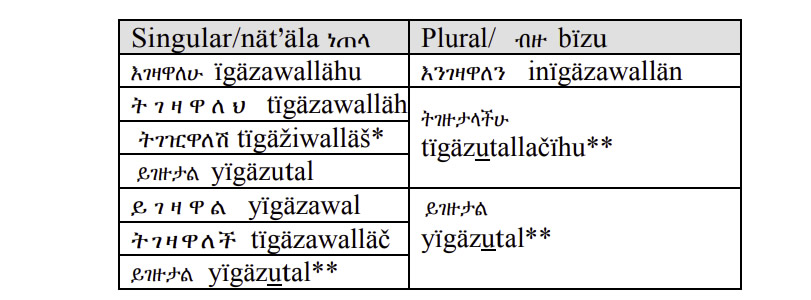Language/Amharic/Grammar/Definite-direct-objects-in-the-present-and-future-tense
In the present/future (compound imperfect) tense, direct object markers are somewhat more complicated. We will present here a basic introduction.
Consider the following examples:
1. ልጁ መስታወቱን ይሰብረዋል lïju mästawotun yïsäbïräwal. The boy breaks (or will break) the mirror. (Lit. The boy the mirror he breaks /(will break) it.)
The infix –w between the root ሰበር säbär and the ending based አለ allä (‘-አል-al’) indicates that the action is done or will be done to the mirror.
- He breaks ይሰብራል yïsäbïral = ይ yï + ሰብር säbïr + - አል al
- He breaks it ይሰብረዋል yïsäbïräwal = ይ yï + ሰብር säbïr + ãው äw + -አል al
2. አልማዝ በሩን ትዘጋዋለች Almaz bärun tïzägawaläč. Almaz closes (or will close) the door. (Lit. Almaz the door she closes (/will close) it.)
- She closes ትዘጋለች tïzägalläč = ት tï +ዘግ zäg + አለች alläč
- She closes it ትዘጋዋለች tïzägawalläč = ት tï + ዘጋ zäga + ው w + አለች alläč
The infix –w is used between the root of the verb and the ending based on allä to indicate the direct object and to make it more definite. –w is used for singular male or neuter (inanimate) direct objects. As with the simple past, the infix –t is substituted for –w following an o– or a u– (as in the forms for እርስዎ ïrswo, እሳቸው ïssačäw, እናንተ ïnantä and እነሱ ïnnäsu). See the following table of the verb mägїzat (gäza) with the direct object infix –w/–t. Meaning ‘buy it’
* The final consonant in the root of the second person feminine form palatalizes following the previously discussed pattern.
* * Note: An additional –u falls before the object marker in the second and third person plural forms. The final –u disappears from the third person plural (yïgäzutal, rather than ይገዙታሉ yïgäzutallu). The –አላችሁ –allačihu ending in the second person plural remains unchanged.
Source[edit | edit source]
https://www.livelingua.com/peace-corps/Amharic/Amharic%20Peace%20Corps%20Language%20Manual-2015.pdf
Other Lessons[edit | edit source]
- Pluralizing
- Conjugation of the verb መኖር “to live” (present tense)
- The Present Future Tense
- Expressing “Let me” or “May I” “Shall I”
- The Present Perfect Tense
- bästä prefix
- Indirect Object Pronouns
- Definite Direct Objects in the Simple Past
- Comparing and Contrasting
- Gender


